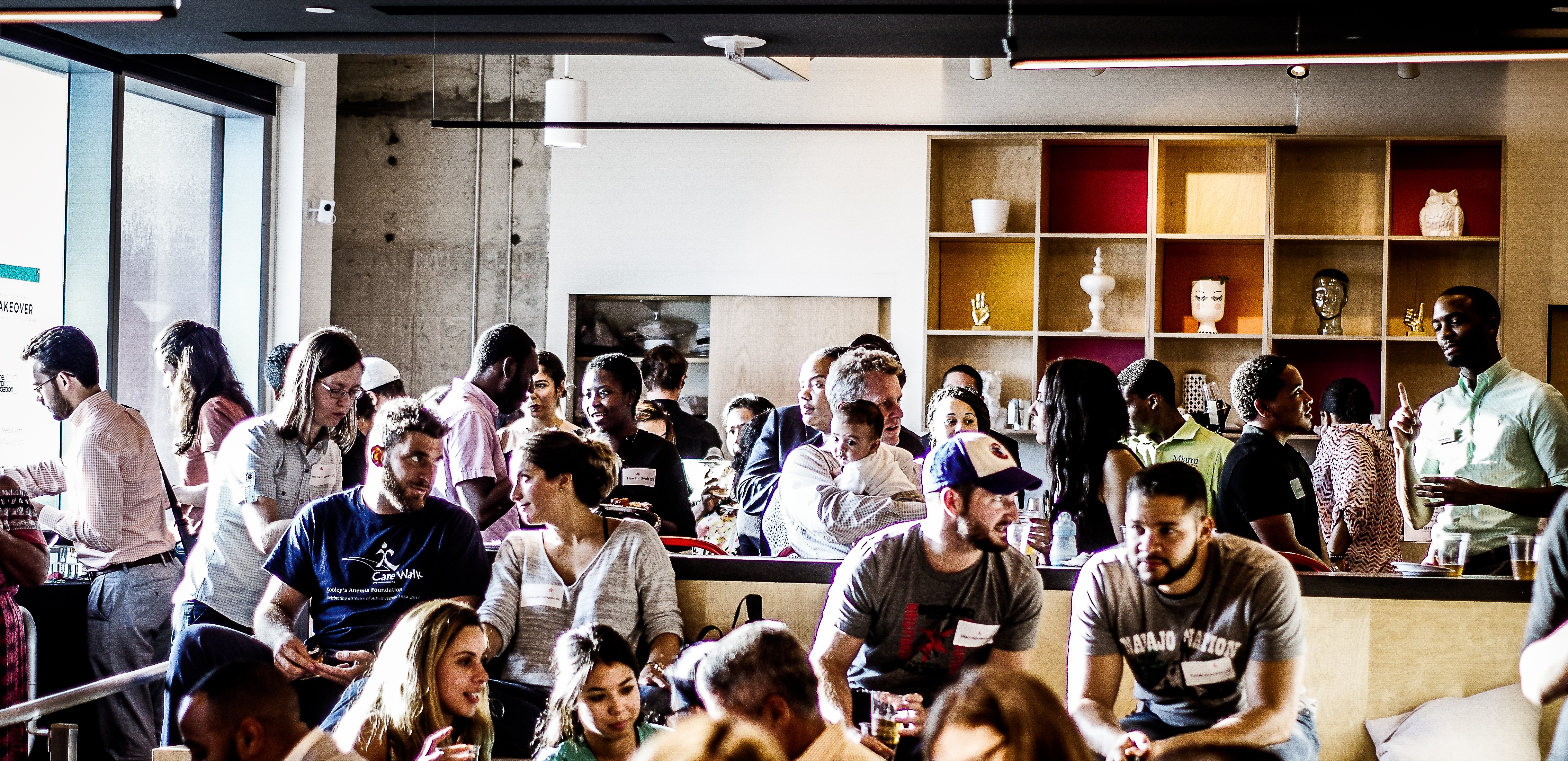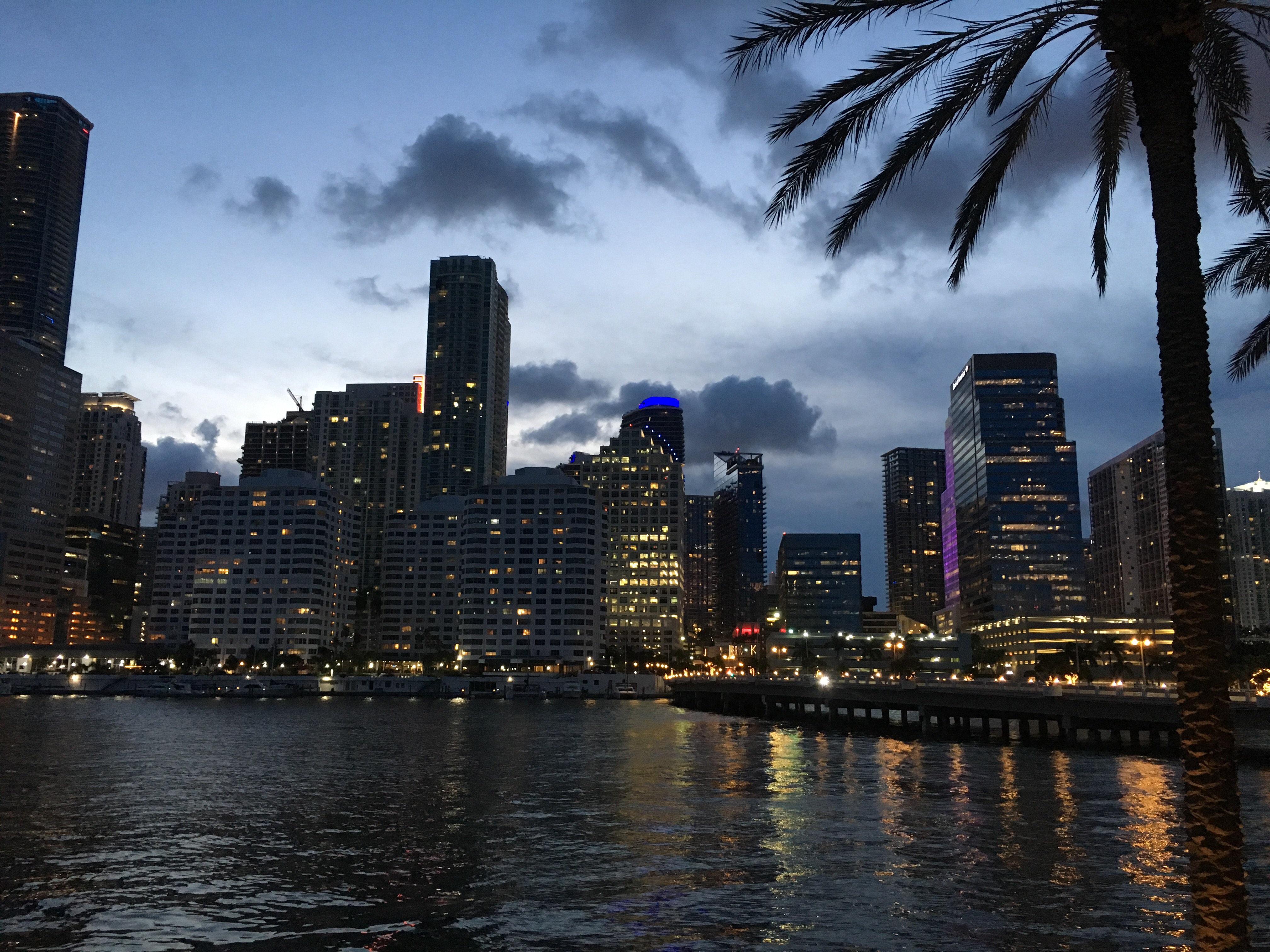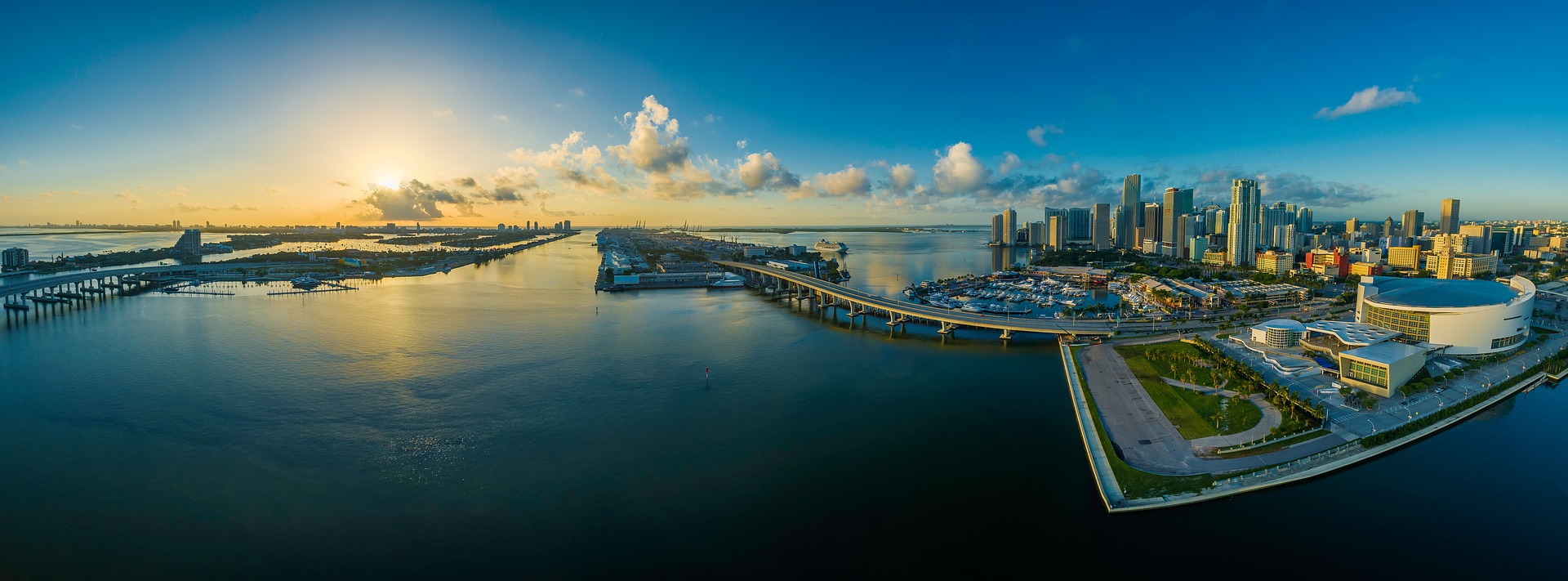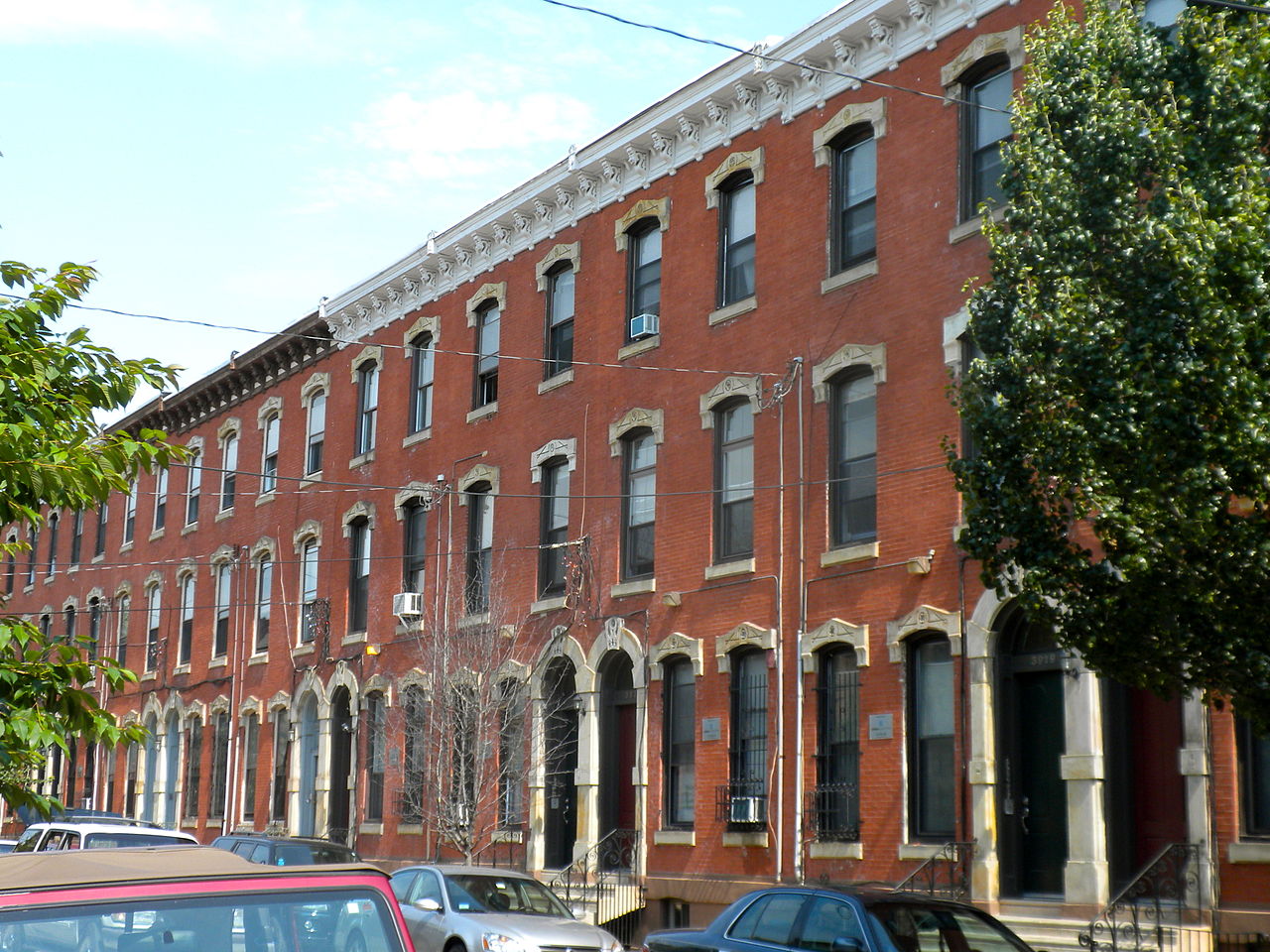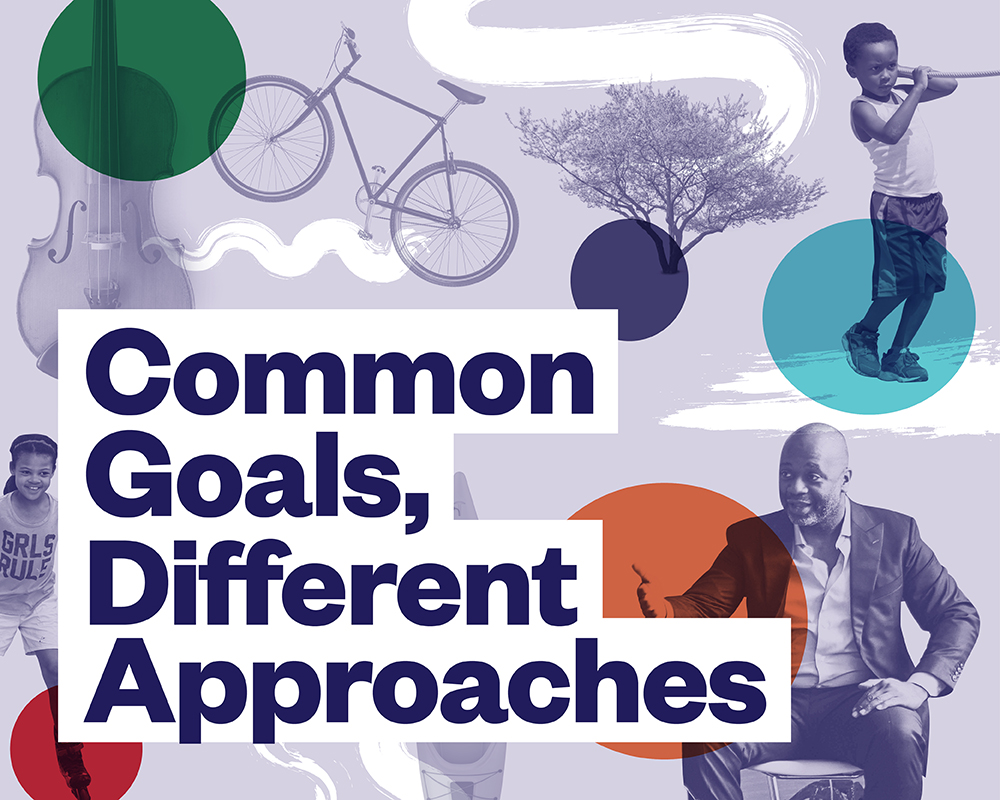To test an intensive site activation strategy at Backesto Park with 11 night market events throughout the summer and a grand finale event that includes Porch Fest (Backesto Park neighbors host live music on their porches).
Program Area: Community Impact
On May 1, 2019, Knight announced more than $1 million in new funding for nine projects to forge greater connections between Miami startup founders and open new pathways for talent and capital. See the press release for the announcement here.
As someone with an almost 2-year-old, I can’t help but notice that building an entrepreneurial ecosystem and raising a child have a lot in common. There’s no instruction manual; each has its own unique needs, strengths and weaknesses; you love watching it grow, but its unpredictability can drive you crazy.
I’d argue the Miami startup community is a teenager: coming into its own, full of promise, and trying to figure out what it wants to be. At Knight, our goal has been and continues to be working collaboratively to nurture this burgeoning community into a self-sustaining, world-class innovation economy—a productive, independent adult, if you will.
Since 2012, Knight Foundation has invested more than $30 million in advancing Miami’s startup community by connecting innovators, attracting investment and growing the city’s talent base. This support has helped drive Miami’s transformation: evolving from a city where you just want to plan a vacation (though that still holds true) to a city where many are growing world-class companies.
Our early bets have helped connect a once fragmented ecosystem. Co-working and innovation hubs including the LAB Miami and the Idea Center, and events such as Black Tech Week and eMerge Americas, have given our community the physical space to come together. We were also able to bring new mentorship and funding opportunities to the city with the local launches of Endeavor Miami, 500 Startups, Miami Angels, and Babson College’s Women Innovating Now.
Examples of Miami’s growth and success are easy to spot: Earlier this year, South Florida tech company Ultimate Software was acquired for $11 billion; younger companies such as Nearpod and CareCloud are thriving; and the city continues to attract the attention of new investors and innovators alike. The potential is palpable.
“Building an entrepreneurial ecosystem and raising a child have a lot in common. There’s no instruction manual; each has its own unique needs, strengths and weaknesses; you love watching it grow, but its unpredictability can drive you crazy.”
At the same time, we recognize the need to target some of our earlier efforts, translating the momentum and activity we are now seeing into intentional impact that will sustain Miami’s growth as an innovation hub into the future. With our startup community reaching adolescence, it’s time to take stock of Miami’s progress — the successes, the struggles and, most importantly, where we go from here.
As part of this process, we spent the last several months actively listening. We picked the brains of more than 200 entrepreneurs, investors and community stakeholders on the ground in Miami’s startup scene. We also consulted research, learning from the insights and experiences of those who have gone before us in building successful startup communities.
We learned a lot, including that a virtuous venture cycle appears to be taking hold (e.g. the former Mako Surgical team founding Magic Leap, Neocis and DermaSensor). We found amazing local teams building world-class companies and attracting high-level investors (see the recent exits of Farelogix and eBuilder). And, we saw that some of the largest, most established companies (think Visa, Lennar, Carnival and Watsco) are building impressive innovation and venture teams right here in our city.
But one finding stood out among the rest, a challenge — or, in our view, an opportunity — that will play a pivotal role in the development of our city’s startup community: We learned that the most fruitful startup communities are those where founders, investors and high-potential talent are strongly connected to each other and are also uplifted by the community at-large. In Miami, we have room to grow on both fronts, and the success of the ecosystem depends on our response.
Almost universally, the founders we met with in South Florida were eager to build peer-learning and mentorship relationships with other founders but didn’t know how to connect with them in a meaningful way. Similarly, people want more direct avenues to connect with talent and investors, and vice-versa, that cut through unnecessary noise.
This requires attention: Research* shows there is a high degree of correlation between a startup community’s success and how the people in those communities connect to and support one another. The inverse is also true.
“The most fruitful startup communities are those where founders, investors and high-potential talent are strongly connected to each other and are also uplifted by the community at-large.”
Since the start, Knight has always taken its cues from community. It’s from the community, after all, that our startup ecosystem was born. And we plan to do the same now. Keeping Knight’s core values of inclusion and participation in mind, we are exploring efforts to foster the growth of Miami’s startup community around three key areas:
- Strengthening connections between the local network of founders, investors and high-potential talent to support learning, growth and community.
- Creating avenues for new talent — from longtime Miami residents to newcomers — to discover and participate in the city’s growing startup community, connecting interest with opportunity.
- Growing Miami’s venture funding capacity by developing new investors; introducing outside capital to the region; and building funding networks that are known and accessible to local entrepreneurs.
As goes with raising a child, priorities, needs and tactics will surely evolve as our ecosystem matures. We have been and will continue to be responsive to the demands of the moment, informed by those in the community who know it best. It truly takes a village to raise a successful startup community. I’m confident Miami can secure its spot as a world-class entrepreneurial hub if we continue to work and adapt together.
Raul Moas is Miami program director at Knight Foundation. You can reach him at [email protected] and follow him on Twitter at @rmoas.
*In his book, Startup Communities, entrepreneur, author, and venture capitalist Brad Feld emphasizes what he believes it takes to create a thriving community of entrepreneurs: “Leaders of startup communities have to be entrepreneurs. Everyone else is a feeder into the startup community. Both leaders and feeders are important, but their roles are different.”
Similarly, in a comparison of several venture ecosystems around the world, Startup Genome found that “local relationships among founders, and the help that is offered between founders, are key determinants of success for both individual companies and the overall ecosystem.”
A recent report by Endeavor Insight sponsored by the Bill & Melinda Gates Foundation arrived at a similar conclusion: “Founders of the fastest-growing companies are much more likely to have received experience, support and investment from leaders of companies that reached scale.”
Image (top): Illustration by Saskia Rasink, titled “Compass real estate agents Miami illustration,” found on Behance; copyright: attribution-NonCommercial-NoDerivatives 4.0 International (CC BY-NC-ND 4.0), no manipulations.
-
Community Impact / Press Release
-
Community Impact / Press Release
-
Community Impact / Article
-
Community Impact / Article
-
Community Impact / Press Release
MIAMI—May 1, 2019—The John S. and James L. Knight Foundation today announced more than $1 million in new funding for nine projects aimed at building deeper connections between local startup founders, investors and high-potential talent, while opening avenues for new talent and investors to participate in Miami’s growing innovation community.
From a series of curated, intimate social gatherings that bring together newcomers and Miami startup veterans as a way to foster stronger networks, to a fellowship program that provides top-performing local university engineering students with professional development and venture opportunities, to an angel network that aims to open new investment prospects to rising entrepreneurs, the projects focus on supporting and propelling Miami’s innovation ecosystem. They also work to create a greater sense of community amongst startup founders, as well as top talent and funders.
“Local connectedness amongst founders, investors and high-performing talent is a major driver of successful startup communities,” said Raul Moas, Knight Foundation program director for Miami. “Through these projects, we hope to forge a deliberate path to growth for Miami’s startups, the impact of which will reap wider benefits for our city as a whole.”
The projects receiving support include:
University of Miami ($250,000): To provide Miami’s startups with greater access to capital by supporting the launch of the Cane Angel Network, which will connect alumni, faculty, staff, parent and other university-affiliated investors with promising university-affiliated companies.
Venture for America ($150,000): To help foster the growth of Venture For America’s Miami program, which places rigorously-selected recent university graduates at high-growth companies for a two-year fellowship. Funding will support the hiring of a dedicated Miami Director.
The Venture Mentoring Team ($150,000): To expand a mentorship program that educates, certifies and credentials seasoned business professionals and connects them with talented rising entrepreneurs to hone their potential.
eMerge Americas ($120,000): To advance the year-long eMerge Americas Fellowship, which invests in the professional development of top-performing local university engineering students and introduces them to opportunities at top-tier Miami-based ventures.
Just Dinner ($114,000): To support a series of curated, intimate gatherings that bring together newcomers and veterans of Miami’s startup community as a way to promote greater connection, a deeper sense of community and stronger social networks.
Creators Council ($106,000): To launch a member-led, peer-sharing and mentorship platform that aims to create a sense of community among founders and high-impact talent by growing the depth and quality of relationships among peers.
American Jewish Committee ($92,000): To foster deeper relationships and opportunities between Miami entrepreneurs and their Israeli peers by introducing a delegation of Miami entrepreneurs to key drivers of Israeli innovation, including decision-makers, entrepreneurs and investors. Miami entrepreneurs will travel to Israel as part of the globally-recognized AJC Project Interchange.
Las Olas VC ($25,000): To help launch the LOVC CEO Summit Series allowing local startup founders and CEOs to connect with their peers and build meaningful relationships.
Miami Angels ($20,000): To make talent and opportunity more easily discoverable by supporting the launch of Talent Scout Miami, a curated platform that helps Miami’s most promising startups find and recruit top talent.
Support for these projects is part of Knight Foundation’s effort to accelerate the development of a startup culture, open to the entire community, that helps make Miami a place where ideas are built and ventures are scaled. Over the past five years, Knight has invested more than $30 million in entrepreneurship in South Florida.
Learn more about this announcement in a blog post by Knight’s Miami Program Director Raul Moas.
About the John S. and James L. Knight Foundation
Knight Foundation is a national foundation with strong local roots. We invest in journalism, in the arts, and in the success of cities where brothers John S. and James L. Knight once published newspapers. Our goal is to foster informed and engaged communities, which we believe are essential for a healthy democracy. For more, visit kf.org.
Contact
Anusha Alikhan, Director of Communications, John S. and James L. Knight Foundation, 305-908-2646, [email protected]
Image (top): Illustration by Saskia Rasink, titled “Compass real estate agents Miami illustration,” found on Behance; copyright: attribution-NonCommercial-NoDerivatives 4.0 International (CC BY-NC-ND 4.0), no manipulations.
-
Community Impact / Article
-
Community Impact / Press Release
-
Community Impact / Article
-
Community Impact / Article
-
Community Impact / Press Release
Leaders in every sector are struggling to plan for a future in which social, digital, political and economic forces create unpredictable change quicker than ever – and the philanthropic field is no exception. To survive and thrive in this turbulent environment, philanthropic leaders must learn to read early signs of imminent upheaval, adapt their organizations in time and take advantage of new opportunities.
In this report, Paul J. H. Schoemaker and George S. Day, research faculty at the Wharton School of the University of Pennsylvania, and Sam Gill, Vice President of the John S. and James L. Knight Foundation, examine the ability of foundations to detect and respond to early signals of threats and opportunities. They surveyed 93 leaders from a wide range of foundations and corporate charities to compare their findings to best practices of global corporations and credit unions, as another non-profit domain.
KEY FINDINGS:
- Most foundations believe that external conditions, such as technology disruptions and changing stakeholders, will impact their work in unpredictable ways.
- While foundation leaders anticipate that greater turbulence is highly likely, most are quite confident in their ability to prepare and adapt in time.
- Foundations best equipped to cope with future uncertainty will need to develop capabilities characteristic of “vigilant” organizations in general.
- “Vigilant” organizations tend to share following key attributes. They:
- Exercise leadership with curiosity, openness and a willingness to play the long game;
- Adopt a flexible and inclusive process around strategic planning, frequently revising priorities and directions as situations change;
- Invest in systems that allow them to anticipate shifts in their business, including directed searches for opportunities to innovate, a portfolio of small experiments and teams focused on forward thinking, innovation and data;
- Alignment around scanning tasks, with clear processes for coordination and accountability to help spot and act on weak signals in time.
- To become more vigilant, foundations and their leaders should: Demonstrate senior level commitment to vigilance by encouraging diversity in new hires and promote to increase the variety of perspectives heard
- Create a diversified network outside their sector and allocate sufficient resources to scan that informal strategic radar system for weak signals
- Invest in organizational capabilities to look ahead and systematize the search for threats and opportunities that are outside as well as inside the organization;
- Create an organizational strategy that encourages input from voices beyond the leadership team and by using “outside-in” approaches to learn faster
- Engage the entire organization in preventing rigid bureaucracy, narrow mindsets and a fear of change, in order to sense and seize future opportunities.
Considering that many foundations scored themselves as well-prepared for additional turbulence, but in fact may not have of the above capabilities in place yet perhaps, senior executives and their boards may wish to conduct a reality check.
They can start by using the survey questions at the end of this report to assess how prepared their own organization really is for the future, and then focus on areas of deficiency so their foundation will truly be able to thrive in an increasingly unpredictable landscape.
-
Community Impact / Report
-
Community Impact / Report
-
Community Impact / Report
- No Time for ComplacencyExternal Content / Website
To support the Manhattan Institute’s Future of Cities white papers and symposia in Knight communities, which will explore key issues that will impact the future of informed and engaged communities.
- How Philanthropies Leverage Opportunity ZonesExternal Content / Website
The Tax Cuts and Jobs Act of 2017 provides a new incentive — centered around the deferral, reduction, and elimination of capital gains taxes — to spur private investments in low-income areas designated by states as Opportunity Zones. Given the significant interest among investors, it is possible that this new tax incentive could attract hundreds of billions of dollars in private capital, making this one of the largest economic development initiatives in U.S. history. If successful, the tax incentive could create new mechanisms for both matching investment capital to market opportunities in neglected communities and ensuring that economic growth redounds to the benefit of people who live in or nearby disadvantaged places.
The broad objective of this new tax incentive — expanding economic opportunities for places and people left behind — cannot be achieved by the market and outside investors alone. Cities in the broadest sense — local governments, urban institutions, urban networks will need to act with deliberate agency and purpose if Opportunity Zones are to spur growth that is inclusive, sustainable and truly transformative for each city’s economy. The implementation of Opportunity Zones, therefore, will be as much about codifying local norms and models as promulgating federal rules and guidance.
Given this perspective, it is clear that philanthropies have a critical role in helping cities realize the full economic and social impact of Opportunity Zones. Foundations often possess the community legitimacy necessary to convene disparate urban stakeholders around hard challenges and intriguing possibilities. They have the discretionary capital necessary to make investments in community development enterprises and other local institutions so these organizations can leverage Opportunity Zones. They have the patient, risk-tolerant capital necessary to invest in Qualified Opportunity Funds, aligned funds or individual transactions. They have the respect for evidence-driven decision making that is conducive to catalyze, capture, codify and communicate new norms and models as they emerge.
The potential role of philanthropies is amplified for foundations like Knight that operate across multiple communities of disparate size, economic profile and market condition. In some respects, the Knight Foundation’s engagement with 26 cities offers a natural lab for experimentation with different kinds of interventions, which will be described below.
This paper identifies seven distinct and complimentary roles for foundations to play:
- They can play a stakeholder convening role by helping cities organize for success by coordinating efforts within government and across key institutions and sectors.
- They can play an asset mapping role by supporting the design and marketing of Opportunity Zone Investment Prospectuses to enable cities, counties and states to communicate their competitive advantages, trigger local partnerships and identify sound projects that are ready for public, private and civic capital.
- They can play a market making role by supporting the collection of market data, the conduct of market research and the provision of patient capital.
- They can play a community building role by helping residents who live in or near Zones express their preferences, obtain skills, start businesses and help improve the quality of life in the neighborhood.
- They can play an institution building role by enhancing the capacity of existing public, private and civic organizations and by creating or supporting new institutions or intermediaries that can help cities design, finance and deliver transformative investments and initiatives.
- They can play an innovation inducing role by using challenge grants and other mechanisms to source pathbreaking ideas among urban stakeholders or push key players to coalesce around coordinated neighborhood investment strategies.
- They can play an information sharing role by speeding the process by which innovative strategies, practices and instruments are captured, codified and communicated.
READ THE FULL REPORT HERE.
PHILADELPHIA – April 18, 2019 – Ellen Hwang will join the John S. and James L. Knight Foundation as the program director based in Philadelphia. She is leader in driving and building programs that advance innovation in local government.

Ellen Hwang (pictured) Hwang will work with local leaders and other community members to find and invest in opportunities that support a more informed and engaged Philadelphia. Knight’s Philadelphia program has recently included significant investments in building public spaces that connect people to place and to each other, including the Reimagining the Civic Commons initiative. She will start on April 22, 2019.
For the last four years, Hwang has served the City of Philadelphia’s Office of Innovation and Technology, where she oversaw the creation of SmartCityPHL, the city’s first roadmap to guide the use of technology in serving the community and improve government services.
“Ellen brings to Knight a deep understanding of Philadelphia, both as a lifelong resident and a leader in public administration,” said Sam Gill, vice president of communities and impact for Knight Foundation. “Her dedication to innovation that begins with residents and her deep knowledge of technology promise to keep Knight at the cutting edge of this rapidly changing community.”
“Philadelphia has always captured my heart and soul. I’m honored and excited to join the Knight Foundation team and be a part of an organization that has deeply invested in the city that I love so much. I look forward partnering with residents and the many organizations who share a vision for a more vibrant, united and engaged city,” said Hwang.
Before working with the City of Philadelphia, she directed programs at the city’s Asian Arts Initiative, collaborating with the community, as well as artists, culture-based organizations and schools to develop and implement youth programs. These efforts worked to empower young people to find their voice and hone their passions by engaging them in arts and community development projects.
Hwang is a member of American Planning Association PA Emerging Professionals, and the CoLab Philadelphia Task Force with Jefferson University. She also formerly served as member of the executive committee and chair for the Artists Committee for Build-a-Bridge Hopeful Cities.
Hwang has lived in the Philadelphia for 13 years; she grew up in Greater Philadelphia. She is a graduate of Temple University, where she received her Bachelor of Arts degree in English and Master of Science in city and regional planning. She is a regular speaker on topics such as Smart Cities, community-driven technology planning and design, and engagement strategies for local government, presenting at prominent events including SXSW, the Smart City New York Conference, and Tech Foundations for Congressional Staffers at the Georgetown University Law Center.
About the John S. and James L. Knight Foundation
Knight Foundation is a national foundation with strong local roots. We invest in journalism, in the arts, and in the success of cities where brothers John S. and James L. Knight once published newspapers. Our goal is to foster informed and engaged communities, which we believe are essential for a healthy democracy. For more, visit knightfoundation.org.
Contact: Anusha Alikhan, Director of Communications, John S. and James L. Knight Foundation, 305-908-2646, [email protected]
Learn more about the report, “Common Goals, Different Approaches,” by reading this blog and the press release.
Introduction
In his 2018 book “The Divided City,” the urban scholar Alan Mallach wrote, “America’s once industrial and now postindustrial cities appear to be on a trajectory to a future in which they become more and more polarized places where bustling, glittering enclaves of prosperity are ringed by declining or largely abandoned areas, and where millions are relegated to lives of poverty and hopelessness.” The American city—which seemed bound for devastation in the 1960s and 1970s and revival in the 2000s—is now on a path toward greater socioeconomic division. And for all the talk of wildly rising costs and metastasizing luxury condos in cities like New York and San Francisco, there are far more places, such as Detroit’s Fitzgerald, Akron’s Summit Lake and Philadelphia’s Strawberry Mansion, that were once stable middleclass neighborhoods but have long been sliding toward disinvestment, neglect and isolation.
The public sector has struggled to halt this slide and connect residents of underresourced neighborhoods to opportunities in thriving areas nearby. It’s an incredibly challenging task, given all the factors at play: economic forces, a history of racial discrimination, poor transit connections, housing inequality, educational shortcomings and a lack of quality public gathering spaces, to name a few. But four foundations have come together to launch an important experiment in breaking down some of these barriers. What would happen, they asked, if a small group of cities received funding to transform a few public spaces each into places where different groups of people could mingle, where investment inequities were rectified, where environmental stewardship and sustainable transit connections were a priority, and where local residents could claim a degree of ownership? If each city were left to its own devices, how would it structure its projects, in terms of leadership, site selection, community engagement, redevelopment strategies and goals? And how would those decisions affect the outcomes?
Reimagining the Civic Commons is an attempt to answer those questions. This three-year national initiative was launched in 2016 with the announcement of a $40 million investment in public spaces in four cities: Detroit; Memphis, Tennessee; Akron, Ohio; and Chicago. The four foundations—the JPB Foundation, the John S. and James L. Knight Foundation, The Kresge Foundation and The Rockefeller Foundation—invested half of the total, with matching funds from local sources. (In a fifth city, Philadelphia, a pilot program that started in 2015 was supported by Knight and the William Penn Foundation.)
Most of the cities are now more than two-thirds of the way through their Civic Commons grant periods, and while much of the work
remains to be done, their projects have taken shape in concrete and meaningful ways. The disparate approaches chosen by the five cities, and the mix of successes and challenges they’ve encountered, show clearly that there’s no simple right or wrong answer to the question of how to create a better civic commons. Instead, they offer different lessons for further efforts, by cities and the partners that support them, to create a richer, fairer, more sustainable and more integrated urban landscape in the future.

Philadelphia: The Pilot: Confronting challenges of geography and community engagement
Ask the leaders of Philadelphia’s Reimagining the Civic Commons initiative what the project’s unifying goal is, and you’ll get as many different answers, from “create these legendary public spaces” (Jamie Gauthier, former executive director for the Fairmount Park Conservancy) to “exploring what public spaces do, not just that they exist” (Patrick J. Morgan, former Philadelphia program director for Knight Foundation) to “it’s less about the projects and more of an idea” (city Commissioner of Parks & Recreation Kathryn Ott Lovell).
Of the five Civic Commons cities, Philadelphia is the outlier. It was the pilot city, and it’s the only one whose grant period is over. Its sites are spread across the city: You would have to travel more than 20 miles to visit them all. And where Memphis is focused on its riverfront and Detroit on one neighborhood, Philly tackled a library, a recreation trail, a park, an old rail line and a new lakeside office building. It’s all over the place, both geographically and conceptually.
Mixed into that complicated assemblage is some great success. Bartram’s Garden is widely hailed across the Civic Commons network as the initiative’s model site; it broke down the perceived barriers between a natural landmark and a neglected neighborhood and made residents feel welcome for the first time. Centennial Commons is bringing investment and programming to a park that lacked both—the park’s inaugural public movie screening, of “Black Panther,” turned out a small but delighted crowd of neighbors—and the Discovery Center is likely to do the same for East Fairmount Park. The Rail Park could be a transformative project that re establishes forgotten connections across the city.
Now that Philadelphia’s Civic Commons grant has expired, the team is applying the lessons of the initiative to other projects in the city—most notably Rebuilding Community Infrastructure (Rebuild), a $500 million citywide neighborhood revitalization program funded largely through a soda tax—and to share them with the Civic Commons cities whose work is ongoing. All of that requires a deep examination of what Philly got right and what it got wrong.
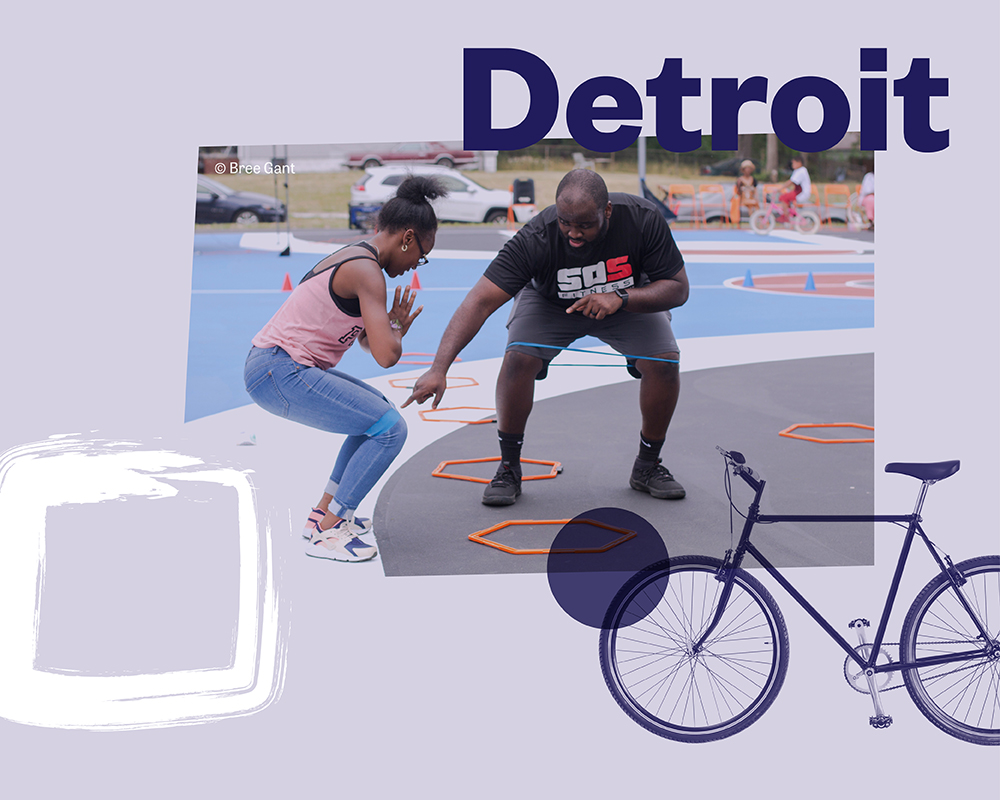
Detroit: Redefining Assets: A city on the rebound turns mass vacancy to its advantage
On the wall of his office, Maurice Cox has pinned a map of Detroit that’s colored like Christmas. Each property in the city is marked red or green— red for occupied, green for vacant, although you could be forgiven for guessing the inverse, since there are at least as many overwhelmingly green patches as red ones.
Downtown Detroit is a block of near-solid red. You don’t need the map to tell you that: Cox’s window looks out onto a dazzling array of skyscrapers connected by a network of footbridges. Radiating from downtown on the map, however, are streaks of green. And 9 miles northwest of downtown is a perfect square dominated by green.
This square is the heart of the Fitzgerald neighborhood. And it’s where Cox, Detroit’s planning director, is focusing a lot of his energy.
Vacancy and blight have plagued Detroit since its steady decades-long decline—precipitated by suburbanization, white flight, riots and the erosion of auto industry jobs—brought the city to its nadir, culminating in its 2013 bankruptcy. Between 2004 and 2014 alone, Detroit lost 244,000 people, enough to form Michigan’s second-largest city. What makes the Fitzgerald project particularly important for Detroit—and different from the other initiatives in the Civic Commons network—is that it’s redefining vacancy as an asset. Other Civic Commons cities have focused on building new assets or restoring old ones. But Cox and his team are taking something that has always been seen as a negative and trying to turn it into a positive.
The view out Cox’s window frames the city’s most obvious asset: the revitalization of downtown Detroit. It began with investments in Detroit’s riverfront and Campus Martius Park in the early 2000s and rapidly accelerated when Dan Gilbert moved his mortgage company, Quicken Loans, into downtown in 2010, purchased a slew of office buildings nearby and lured other businesses to the downtown core. Now, on a warm summer evening, you can find groups of business travelers in work attire hopping between downtown’s high-end restaurants and bars, and large numbers of locals strolling along the pristine RiverWalk, with sweeping views of Canada across the Detroit River. To the north, in Midtown, hipsters and young professionals patronize breweries, boutiques and museums.
The success of Detroit’s downtown differentiates it from other Civic Commons cities, such as Memphis, which is focusing its efforts on downtown to restore the city’s center and sense of place, and Akron, which is putting resources into downtown and seeking to connect it with areas that have more population and off-hours foot traffic.
The recovery of downtown Detroit is well underway. It serves as a visible reminder of what Detroit writ large could be, and of what it used to be, before the city of 1.85 million was reduced to a 670,000-person shell. The goal now is to help the recovery spread throughout the city. The Civic Commons project in Fitzgerald is, more than anything, an effort to revive a sagging neighborhood and give it attractive public amenities it has long lacked. But it’s also a proof of concept for the rest of the city. If vacancy can become an asset in this quarter square mile, can it also be used to revive Detroit?

Memphis: Rewriting the Narrative: Addressing a complicated history through a riverfront revitalization
The kayak race was, by any normal standard, a modest one. The dozen or so participants paddled at a leisurely pace. One had the advantage of a coxswain aboard—a dog in a bright green life vest, perched on the prow—but still trailed the pack. A drone captured footage of the contest for all of 30 seconds before crashing into a pedestrian bridge, breaking in two and plummeting into the river.
But for Carol Coletta, president of the Memphis River Parks Partnership, the mere presence of all these kayaks in the Wolf River Harbor, an offshoot of the Mississippi, was cause for celebration. “Look at these people!” she exclaimed. “This is great!”
The Memphis riverfront’s journey to this moment proceeded about as quickly as the Wolf River Harbor’s languid current. There was a time when the river put Memphis on the map; when the commerce it brought made the city the world’s top market for cotton, hardwood and mules; when the adjacent downtown flourished and grew. Then steamboats and mules were supplanted by railroads and cars. The city’s center of gravity pulled eastward, toward the highways and the suburbs.
Downtown declined slowly, then suddenly, with a gunshot fired at the balcony outside Room 306 of the Lorraine Motel in 1968. “After Dr. King’s assassination, downtown Memphis died,” said Robert Montgomery, a member of the Downtown Memphis Commission’s Blue Suede Brigade, which provides security and assists visitors. The exodus of people from downtown was followed by an exodus of business, and blight and crime took their place.
Now, residents tell a consistent story: Sometime in the past 10 to 15 years, something started to change. Downtown began its comeback. But like the decline, it started slowly, almost imperceptibly. That’s why a small milestone like a kayak race seemed so significant.
Still, in the context of the surrounding areas, the downtown Memphis riverfront remains the laggard. “Our part of downtown is pretty sleepy in general,” said Maria Fuhrmann, the city’s grants coordinator and Civic Commons lead. “There’s nodes of activity to the north and south, but this is the missing middle.” As with Detroit’s Civic Commons project, which seeks to build an enlivened connection between two universities, the aim is to bridge those nodes and make the underserved center feel vibrant and valuable. It’s no coincidence that Detroit and Memphis are the two most segregated Civic Commons cities, where well-resourced areas can sandwich such underinvested ones.
Other recipients of Civic Commons grants focused on neighborhoods, buildings and parks that had been largely forgotten in the public consciousness. Memphis set its sights on its most obvious landmark: the riverfront. And Aug. 4, 2018, was its coming-out day.

Akron: Think Small: Aiming for bunts, not home runs, in community-driven planning
It seemed like such an everyday scene: Two women and their children walked down a small slope, sat on a pair of bench swings and looked out at Summit Lake. But captured in that tableau was the success of Akron’s Civic Commons strategy.
In a network with grand ambitions to transform the way urban communities interact with public spaces, Akron’s Civic Commons initiative could be summed up with a different sort of motto: Think small.
Not only is Akron the smallest Civic Commons city by far—at 197,000, its population is one-eighth of Philadelphia’s and one-fourteenth of Chicago’s— but it has intentionally shied away from grandiose projects. Where Memphis is seeking to reshape its riverfront, Detroit is transforming acres of vacant land into a major community asset and Chicago is aiming to change the way cities approach the arts, Akron asked Summit Lake residents what they wanted, and they said seating, tables and shade. So that’s what they got. And by restoring access to the lake and fulfilling those simple requests, the city did more to build trust than any monumental construction could have.
“I don’t think we ever went about this saying we were going to change the landscape of Akron,” said Dan Rice, president of the Ohio & Erie Canalway Coalition, which is leading Akron’s Civic Commons project.
Memphis, by contrast, has been tackling “a really giant project,” said Kyle Kutuchief, the Knight Foundation program officer in Akron. “And ours is really a sum of small parts.” There are improvements to a recreation trail. There are new activities in once-deserted downtown squares. And there are some very well-used picnic tables. Akron has tried for too long to hit grand slams, like huge development projects and efforts to fix the economy by luring big companies. Now, Kutuchief said, the city is going for “bunts and singles.”

Chicago: An Artist’s Vision: Theaster Gates’ art-fueled empire transforms a slice of the South Side
The musicians at the front of the room raised their instruments, paused and then launched into a rambunctious string quartet by the African-British composer Samuel Coleridge-Taylor.
The sound rang through the hall, an old bank lobby not designed for acoustics but very well-suited to the purpose. An ornate ceiling arched overhead, affording a peek at a soaring two-story library housing the personal collection of the legendary African-American publisher John H. Johnson, the late founder of Ebony and Jet magazines. An array of children sat on a rainbow of colorful pillows up front, while the grown-ups filled benches behind them, rapt and silent until they broke into applause.
The musicians, all black, announced their next piece. Like the others in the D-Composed series, it was by a black composer and under five minutes long. They invited the kids to clap and the adults to stomp to the beat as the violins soared and the cello plunked a rhythmic line.
Elsewhere across the Civic Commons network, cities are creating parks, libraries and trails. Chicago is different, in a few obvious and less obvious ways. Most apparent is the focus on the arts. String quartets have yet to feature in the other Civic Commons initiatives; here, they’re center stage— literally at the Stony Island Arts Bank, and figuratively at Chicago’s other sites, which all seek to foster artistic creation. Then there’s the person at the heart of it all, renowned South Side artist Theaster Gates. In the other cities, the projects are the product of extensive partnerships and collaboration, but Chicago’s projects are largely Gates’ brainchild. And where the project sites elsewhere are mostly owned by municipal governments or nonprofits working closely with the city, Gates himself controls most of the properties his team is working on.
Does that allow Gates to move the projects swiftly without waiting for government cooperation? “Absolutely not,” he said with a laugh. He still relies on the city and development partners, and he wishes he had sat down with the mayor at the beginning of the process to get buy-in and participation from these partners at the onset of the Civic Commons initiative.
But his ownership of the projects does allow him to do something different, and something he considers more valuable. “One of the things that neighborhoods need more of is autonomous local voices to determine an agenda that is not necessarily set by a municipal public,” he said. If the city controls a development project, it’s answerable to the will of voters, who are likely to want basic services like grocery stores. If a private developer does, it tries to maximize income, maybe by luring a national chain retailer. “My thinking is, there are other players who should try to determine the fabric,” he said. “And those players have different expertise than national interests.”
In this case, he’s the player. That comes with pitfalls, but also promise: Gates has a vision for the South Side of Chicago, one that Civic Commons is helping him realize more comprehensively than ever, and it’s beginning to transform a once-neglected neighborhood—or at least a small corner of it.
-
Community Impact / Article
-
Community Impact / Press Release
On April 18, 2019, Knight released the report “Common Goals, Different Approaches.” Learn more by reading the blog below and this press release.
Three years ago, Knight Foundation joined with the Kresge Foundation, JPB Foundation and Rockefeller Foundation to support an experiment. Would it be possible to revitalize and connect disused civic spaces to foster greater civic engagement, promote economic development and enhance environmental sustainability?
The project took root in five, diverse cities: Akron, Ohio; Chicago; Detroit; Memphis, Tennessee; and Philadelphia. Each city invested significant additional public and private resources, and began to build a network of parks, plazas, trails and libraries.
Three years later, each city has made progress. Each city has also made this work their own—authentic to its own people, its own ethos and its own priorities. We asked journalist Aaron Wiener to go out and understand how this effort took on a life of its own in each community. Wiener is a senior editor at Mother Jones and has reported on a number of urban economic development issues. His work was independent. He came back with a vivid portrait of an effort that is both changing community and changed by community, an effort now as disparate as the places where it lives.
In Philadelphia, the effort became the testing ground for a citywide approach to the use of public space. Now, municipal resources are backing a $500 million neighborhood investment program focused on updating, programming and revitalizing key neighborhood assets like parks, libraries and recreation centers.
In Detroit, the project became about inverting one of the city’s core liabilities – mass vacancy – into an asset. The effort is taking vacancy and using it as the canvas on which to build new greenspaces at the center of neighborhood redevelopment that includes new housing opportunities and a revitalized commercial corridor.
Read the full report
In Memphis, Reimagining the Civic Commons is about the reawakening of Memphis’ downtown, and the reclaiming of the river as the center of civic life—for everyone.
In Akron, the project is about taking on civic life small bites at a time. The effort has made incremental changes to different key nodes of city life – a beautiful lake south of downtown in a neglected neighborhood, a park in a transitional neighborhood downtown, and a historic trail that is a regional draw but not yet a vital interface between visitors and residents.
And, in Chicago, the “civic commons” has been an opportunity for innovative artist Theaster Gates to reimagine just exactly what community means. Led by his vision, the project has created unusual new spaces where people, culture and art come together to reclaim a different vision for the city’s South Side.
At Knight Foundation, we believe community change happens when we are able to work with residents and other partners to unleash and accelerate what’s already moving in community. Perhaps the greatest success of the experiment that is Reimagining the Civic Commons isn’t one idea. It’s a set of values about the importance of civic spaces—values that can be interpreted and applied differently in different contexts.
Sam Gill is the vice president for communities and impact at Knight Foundation.
Lynn Ross is the founder and principal of Spirit for Change Consulting, LLC; she is Knight Foundation’s lead consultant for its work supporting RCC.
Read the full report, “Common Goals, Different Approaches” here.
-
Community Impact / Report
-
Community Impact / Press Release
MIAMI—April 18, 2019—As American communities face increasing levels of social and economic division, a new report showcases how five U.S. cities are reimagining public spaces—parks, trails, plazas, libraries—to bring residents together and revive neglected neighborhoods.
The report, “Common Goals, Different Approaches,” commissioned by the John S. and James L. Knight Foundation, traces projects in Akron, Ohio; Chicago; Detroit; Memphis, Tennessee; and Philadelphia to revitalize and connect civic assets as a means to influence positive social and economic outcomes.
“The journey to create great public spaces is unique for each city, but the goal is the same: to strengthen community connection, trust and engagement,” said Sam Gill, Knight Foundation vice president for communities and impact. “While there’s no one-size-fits-all approach to revitalize and connect civic assets, these case studies show the most successful strategies are those shaped by resident insights and involvement.”
The efforts are part of Reimagining the Civic Commons (RCC), a three-year, national initiative that formally launched in 2016 with $20 million in support from The JPB Foundation, Knight Foundation, The Kresge Foundation and The Rockefeller Foundation—and another $20 million in matching funds from local partners. The initiative was piloted in Philadelphia in 2015 with $11 million in support from Knight Foundation and the William Penn Foundation.
With two-thirds of the RCC initiative complete, the report provides a qualitative look at the successes and challenges experienced by the participating cities so far. It offers lessons learned for other communities exploring the potential of public spaces to connect residents of all backgrounds, foster civic engagement, advance environmental sustainability and promote economic development.
The report details progress made in each of the cities:
- In Philadelphia, the first city to participate in RCC and conclude its RCC program, five new civic assets were created, including parks, trails and a library, each connected to evolving neighborhoods. RCC broke down perceived barriers between natural landmarks and neighborhoods, and made residents feel welcome for the first time at previously neglected sites. The city is now applying lessons learned from RCC to other projects, including Rebuild, a $500 million citywide neighborhood revitalization program.
- In Detroit, RCC efforts are redefining vacancy as an asset and changing residents’ perceptions of city government, which is leading the initiative in collaboration with nonprofit and neighborhood partners. The city has garnered new trust from residents by engaging them in the projects’ development and by investing in its planning department, growing from six city planners in 2015 to 36 today, to deliver on residents’ expectations. The results point to a new model for neighborhoods across the city, tackling vacancy and blight. So far, the project, centered in the Fitzgerald neighborhood, has turned empty lots into a neighborhood park, rehabbed houses and reactivated the commercial corridor with new store fronts.
- In Memphis, partners are leveraging the city’s riverfront to bring vibrancy back to downtown by creating a space welcoming to all. Through grassroots community engagement efforts, the project is overcoming legacy local issues—economic disparity, segregation and concerns that the downtown area is unsafe and unwelcoming—and writing a new neighborhood narrative.
- In Akron, the smallest city participating in RCC, project leaders are prototyping with small-scale projects, informed by and in partnership with residents, setting the stage for a large, collective impact in the long-term. Downtown Akron continues to struggle with population loss that began decades ago, with many people only driving in and out for work. RCC is slowly changing this dynamic by investing in isolated neighborhoods and the Ohio & Erie Canalway Towpath Trail that connects them. In addition to reestablishing the 100-acre Summit Lake as an inviting public space, RCC is making Akron a more attractive place to live, work and play for current and potential residents alike.
- In Chicago, renowned local artist Theaster Gates, who leads the city’s RCC project and manages most of the properties involved through his nonprofits, is using the arts and culture to turn underutilized assets on the South and West sides of Chicago into vibrant civic places. A cultural district is in the making, aimed at fostering opportunity for residents in historically underserved neighborhoods. The remodeled Stony Island Arts Bank, a former financial building, is at the heart of the master plan, with additional RCC projects underway to transform and connect nearby vacant assets.
The report follows a series of quantitative assessments shared last week by Reimagining the Civic Commons that track changes in the social impacts of improved public spaces in the participating cities, excluding Philadelphia. The interim data show that investments in public spaces have improved residents’ perceptions of neighborhoods, with many reporting they feel safer and more optimistic about the future of the areas.
“Reimagining the Civic Commons is an experiment to explore the potential of public spaces to bridge divides and build more resilient communities,” said Lynn Ross, Knight Foundation’s lead consultant for its work supporting RCC. “The experiment is one from which we will never stop learning, and the more outcomes shared, the better. As cities undertake new public space initiatives, it’s invaluable to learn from the good and the bad of efforts gone before, such as those highlighted in Knight’s new report.”
Knight Foundation believes public spaces have the power to transform communities, and they are a key part of our work to build more informed and engaged communities. Knight has made major investments in this area, both nationally, including through support for Reimagining at the Civic Commons, and at the local level. Earlier this year, we launched the inaugural Knight Public Spaces Fellowship, which supports exemplary leaders who transform the way we think about and use public spaces in the communities where we live. Learn more about Knight’s public spaces work and strategy here.
Learn more about the report, “Common Goals, Different Approaches,” by reading this blog.
About the John S. and James L. Knight Foundation
Knight Foundation is a national foundation with strong local roots. We invest in journalism, in the arts, and in the success of cities where brothers John S. and James L. Knight once published newspapers. Our goal is to foster informed and engaged communities, which we believe are essential for a healthy democracy. For more, visit kf.org.
Contact
Anusha Alikhan, communications director, Knight Foundation, 305-908-2646, [email protected]
-
Community Impact / Article
-
Community Impact / Report
Support the Responsible Landlord Engagement Initiative (RLEI) that brings together tenants to engage their landlord to first resolve blight issues in neighborhoods. These groups establish trust and build ongoing relationships in the community.

